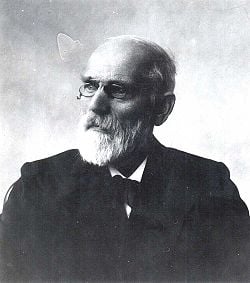Johannes Diderik van der Waals
|
Johannes van der Waals | |
|---|---|
 Johannes Diderik van der Waals | |
| Born |
November 23 1837 |
| Died | March 8 1923 (aged 85) |
| Residence | |
| Nationality | |
| Field | Physicist |
| Institutions | University of Amsterdam |
| Alma mater | University of Leiden |
| Academic advisor | Pieter Rijke |
| Notable students | Diederik Korteweg |
| Known for | van der Waals equation of state |
| Notable prizes | |
| He is notably the father of the poet Jacqueline Elisabeth and the physicist Johannes Diderik Jr. | |
Johannes Diderik van der Waals (November 23, 1837 – March 8, 1923) was a Dutch scientist and thermodynamicist famous for his work on the equation of state for gases and liquids which describe the relation between the pressure, volume, and temperature of fluids (gases and liquids). In 1873 he obtained his doctor's degree at Leiden university for a thesis entitled Over de Continuïteit van den Gas- en Vloeistoftoestand (On the continuity of the gas and liquid state). In this thesis he derived the equation of state bearing his name. The importance of this work is that it gave a model in which the liquid and the gas phase of a substance merge into each other in a continuous manner. It shows that the two phases are in fact of the same nature. In deriving his equation of state van der Waals assumed not only the existence of molecules (which in physics was disputed at the time), but also that they are of finite size and attract each other. Since he was one of the first to postulate an intermolecular force, however rudimentary, such a force is now sometimes called a van der Waals force.
A second great discovery of van der Waals was published in 1880: The Law of Corresponding States. This law shows, that after scaling temperature, pressure, and volume by their respective critical values, a general form of the equation of state is obtained which is applicable to all substances. This law served as a guide during the experiments that led to the liquefaction of helium by Heike Kamerlingh Onnes.
Van der Waals found his incentive for his life's work after reading the 1857 treatise by Rudolf Clausius entitled Über die Art der Bewegung welche wir Wärme nennen (On the Kind of Motion which we Call Heat).[1] Van der Waals was later greatly influenced by the writings of James Maxwell, Ludwig Boltzmann, and Willard Gibbs. For his work he won the 1910 Nobel Prize in physics.
Family
- spouse: Anna Magdalena Smit (m. 1864)
- children: Anne Madeleine, Jacqueline Elisabeth (poet), Johanna Diderica, Johannes Diderik Jr. (physicist)
Biography
Van der Waals was born in Leiden, the Netherlands, as the son of Jacobus van der Waals and Elisabeth van den Burg. He became a school teacher, and later was allowed to study at the university, in spite of his lack of education in the field of classical languages. He studied from 1862 to 1865, earning degrees in mathematics and physics. He was married to Anna Magdalena Smit and had three daughters and one son.
In 1866, he became director of a secondary school in The Hague. In 1873, he obtained a doctorate degree in Leiden under Pieter Rijke. In 1876, he was appointed the first professor of physics at the newly established University of Amsterdam.
Van der Waals died in Amsterdam in 1923, one year after his daughter's death.
See also
- Van der Waals equation
- Van der Waals forces
- Van der Waals radius
- Van der Waals (crater)
ReferencesISBN links support NWE through referral fees
- ↑ Van der Waals, Johannes, D. (1910). "
 PDF." Nobel Lecture, Dec. 12.
PDF." Nobel Lecture, Dec. 12.
Further reading
- Kipnis, Aleksandr Yakovlevich and Boris Efimovich Yavelov, and John Shipley Rowlinson (July 1996). Van der Waals and Molecular Science. Oxford University Press. ISBN 0-19-855210-6.
External links
- Scientists of the Dutch School Van der Waals, Royal Netherlands Academy of Arts and Sciences
- Albert van Helden Johannes Diderik van der Waals 1837 – 1923 In: K. van Berkel, A. van Helden and L. Palm ed., A history of Science in the Netherlands. Survey, Themes and Reference (Leiden: Brill, 1999) 596 - 598.
- Johannes Diderik van der Waals - Biography at Nobelprize.org.
- Museum Boerhaave
 PDF
PDF - H.A.M. Snelders, Waals Sr., Johannes Diderik van der (1837-1923), in Biografisch Woordenboek van Nederland.
- Biography of Johannes Diderik van der Waals (1837 – 1923) at the National library of the Netherlands.
| ||||||||
| Persondata | |
|---|---|
| NAME | Waals, Johannes van der |
| ALTERNATIVE NAMES | |
| SHORT DESCRIPTION | Physicist |
| DATE OF BIRTH | November 23, 1837 |
| PLACE OF BIRTH | Leiden, Netherlands |
| DATE OF DEATH | Diederik Korteweg |
| PLACE OF DEATH | Amsterdam, Netherlands |
ar:فان دا فالس bn:ইয়োহানেস ডিডেরিক ফান ডার ভাল্স bs:Johannes Diderik van der Waals bg:Йоханес ван дер Ваалс ca:Johannes Diderik van der Waals cs:Johannes Diderik van der Waals da:Johannes Diderik van der Waals de:Johannes Diderik van der Waals es:Johannes van der Waals eo:Johannes Diderik van der Waals fr:Johannes Diderik van der Waals gl:Johannes Diderik van der Waals ko:요하네스 디데릭 판데르 발스 hr:Johannes Diderik van der Waals io:Johannes Diderik van der Waals id:Johannes Diderik van der Waals it:Johannes Diderik van der Waals he:יוהאנס דידריק ואן דר ואלס mr:योहान्स डिडरिक व्हान डेर वाल्स nl:Johannes Diderik van der Waals ja:ヨハネス・ファン・デル・ワールス no:Johannes Diderik van der Waals oc:Johannes Diderik van der Waals pl:Johannes Diderik van der Waals pt:Johannes Diderik van der Waals ro:Johannes Diderik van der Waals ru:Ван-дер-Ваальс, Ян Дидерик sk:Johannes Diderik van der Waals sl:Johannes Diderik van der Waals fi:Johannes Diderik van der Waals sv:Johannes Diderik van der Waals tr:Johannes Diderik van der Waals zh:约翰尼斯·迪德里克·范·德·瓦耳斯
